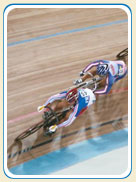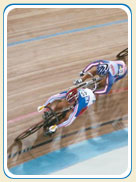As the Tour de France rolls onto stage 7, few in the general public know of the story of 21-year-old Linas Rumsas, but they need to consider it. Especially on this day, July 13, 2018, the 51st anniversary of cyclist Tommy Simpson’s death.
People ask us all the time why doping control matters. Some argue that it doesn’t and that we should just let folks use what they want. A doping free-for-all. Cynics might say that plenty of dopers have already escaped through the net in sports, at least for a time: Lance Armstrong, Tim Montgomery, Marion Jones, to name a few.

Linas Rumsas was an up-and-coming cyclist whose life was cut short after he abused performance-enhancing drugs. Photo: Team Altopack-Eppela
The story of young Linas, a promising cyclist whose life was cut short after abusing performance-enhancing drugs, reminds us that doping can kill. We would be wise to remember that it has happened before. Linas’ story is one of the saddest we have come across and it powerfully demonstrates why many of us who have chosen to pursue anti-doping continue to do so. This one story illuminates in no uncertain terms the realities of what we all face with the scourge of doping, and yet outside of Italy and frequent readers of Cycling News, few sports fans have probably heard of it.
There have been others who have perished from doping. According to ProCon, which provides a comprehensive historical timeline of doping in sports, the first modern athlete chronicled to have died from doping was the Danish cyclist Knut Jensen at the Summer Olympics in Rome in 1960. Heat was the initial culprit but his autopsy found traces of Ronicol. ProCon describes Ronicol as an amphetamine, but Ronicol would be described more accurately as a vasodilator and can be used as an anti-ischemia drug. Though it is not on the 2018 WADA Prohibited List, it is similar to meldonium in many ways.
Stop to consider that the first drug to have been implicated in the death of an athlete in the Olympics in 1960 is not banned today! Ronicol, otherwise known as nicotinyl alcohol, is not prohibited as confirmed by the Global DRO. Its cousin meldonium wasn’t prohibited by WADA until 2016, when it caused hundreds of athletes to test positive. Some might like to think that doping is behind the peloton, but we fear it may still be in the middle. Just in a form we don’t currently define as doping, like Ronicol.
Fifty one years ago today on July 13, 1967, Tommy Simpson infamously died on the slopes of Mount Ventoux during Stage 13 of the Tour at the age of 29. His death was one of the central moments in anti-doping history. Shortly thereafter that same year the International Olympic Committee (IOC) created the IOC Medical Commission and the first drug testing began at the Olympics in 1968, with narcotics and stimulants making up the initial prohibited list. Steroids were not added until 1975.
There have been other examples of athlete deaths that have been seminal. MLB pitcher Steve Bechler, of the Baltimore Orioles, died during drills in 2003. Ephedrine was indicated as a contributing cause in his premature death, which played a role in the regulation of ephedrine as a dietary supplement ingredient in the United States.
Steroids have played a role in the demise of many young athletes, including Taylor Hooton, Efrain Marrero, and just two days ago, a young 18-year-old Irishman in Limerick. Numerous stories exist of athletes who went too far with blood doping, or performed transfusions the wrong way, leading to dire consequences. Many stories are out there but few are known to the broader sporting public.
Linas Rumsas’ story reminds us that the scourge of doping is still present and that it is just as deadly today as it was in 1967 when amphetamines derailed the promising life and career of Mr. Simpson.
Linas Rumsas is the son of Raimondas Rumsas, who himself was a professional cyclist and took third place in the 2002 Tour de France. After Raimondas’ wife Edita was caught with a van full of drugs on the way home from that Tour, they both received four-month suspended sentences in 2006. Raimondas later tested positive for EPO during the 2003 Giro d’Italia. Sadly, this experience did not seem to deter them from apparently assisting their two children with doping.
Linas rode for the Altopack-Eppela squad in Italy and had already been a national road race champion. But in May 2017, he died at age 21 of a heart attack. It was nearly 50 years to the day after Mr. Simpson had died.
Upon Linas’ death, police searched his family’s home and seized a number of banned substances and medications. In September 2017, his older brother Raimondas Jr. tested positive for the prohibited substance GHRP-6, a peptide that produces natural growth hormone. It seems a cocktail of banned substances and other medications were being used at the family home.
The result of all this has been one family torn apart, again, from doping. Perhaps doping didn’t matter to the Rumsas family either until their son died. But Linas didn’t just die, if the allegations in this case hold true. He died as a result of family support and encouragement to dope.
It gets worse. In the course of the investigation, six people have been arrested in an apparent team-sponsored doping program including the team owner, directeur sportif, pharmacist, and trainer, who stand accused of providing drugs to riders. Seventeen other people are being investigated. Sadly, however, it is too late for Linas.
Unfortunately, the recent decision to allow Chris Froome to ride again with no sanctions after testing positive for elevated levels of salbutamol has called into question the validity and utility of the anti-doping system, again, at least in some people’s eyes. WADA has tried to explain the reasoning now, including clarifying the levels (1,428 ng/ml of urine, when adjusted for specific gravity, which is above the decision limit of 1,200 ng/ml). The reasons may not satisfy everyone, or anyone, but Froome’s case is certainly not a reason to give up on anti-doping.
Linas’ story personifies why giving up on anti-doping is simply not an option and should remind us all that doping is a significant matter. In fact, it is all the more reason to recognize that the failures of the anti-doping system are largely due to a lack of resources and money. For that to change, more people will need to truly understand what is at stake when athletes dope and to demonstrate the will to do more to combat the problem.
– Oliver Catlin




 Unfortunately, an effective blood boosting drug in pill form is also the Holy Grail for endurance dopers. Though
Unfortunately, an effective blood boosting drug in pill form is also the Holy Grail for endurance dopers. Though  professional cyclist in the UCI Tour makes $142,000, according to Ernst & Young
professional cyclist in the UCI Tour makes $142,000, according to Ernst & Young
